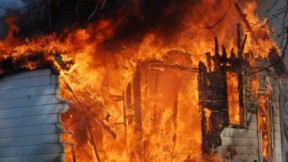In keeping with its profile as a fat-loving, bioaccumulating toxic chemical, HBCD appears in higher levels in predators like porpoises and falcons. It’s also been found in human fat tissue, blood and breast milk. Testing the possibility that the chemicals could enter our bodies through food, researchers found HBCD in 42 percent of foods purchased in Dallas grocery stores. Canned sardines and smoked turkey sausages had the highest levels, in keeping with other studies suggesting that fatty foods could be an important exposure pathway.
Studies in animals indicate that HBCD disrupts hormone function and interferes with the developing nervous system. Less is known about TCPP, though it’s also been detected in human breast milk and causes developmental and neurological defects in animal studies.
Fire-safe buildings without chemicals
Building standards regulating foam insulation date back to the 1960s, and required that products pass the “Steiner Tunnel” test, which measures flame spread from the bottom of a tunnel to its ceiling, outfitted with insulation. In the 1970s, the thermal barrier requirement was added to protect exposed insulation because, Babrauskas and his coauthors assert in their recent study, insulation proved highly flammable even after passing the Steiner test. Using flame retardants when a thermal barrier is present, the authors concluded, does not add a fire safety benefit.
AB 127 calls on the State Fire Marshall to review California’s flammability standards for building insulation and work with government officials to ensure fire safety “while giving full consideration to the long-term human and ecological health impacts associated with chemical flame retardants.”
After Skinner made her case before the state Senate committee on Monday, several witnesses spoke in support of the bill, including Justin Malan of the U.S. Green Building Council California. Malan argued that although the builders, architects, planners and engineers he represents strongly support energy efficiency, they know that sometimes building materials need careful review. “Let’s not make the same costly, and lethal, mistakes we made with asbestos,” he said.
Arlene Blum, executive director of the Green Science Policy Institute and a chemist who has long sounded the alarm about the potential hazards of flame retardants, urged the committee to follow the lead of Governor Brown, who directed regulators to update the state’s furniture flammability standards to increase fire safety without using potentially toxic chemicals.
Existing building standards require 15 minutes to flashover, when the fire turns from flame to conflagration as nearby combustibles ignite. By the time a fire hits the treated plastic foam insulation inside the wall, Blum said, “all the flame retardants do is make the fire more toxic, produce dioxins, which harm the health of first responders.”
Lobbying against public health?
Twelve public interest and business groups followed Malone and Blum in support of AB 127. Leading the opposition to the bill was Joe Lang, representing the chemical industry’s main trade group, the American Chemistry Council.
Lang, a veteran Sacramento lobbyist who once represented tobacco giant Philip Morris, now heads the top-grossing lobbying firm in Sacramento. His firm received more than $1 million from chemical industry interests over five years to help defeat five bills to regulate flame retardants added to consumer products. In the first quarter of this year, Lang and his associates have earned 40,000 from the American Chemistry Council, state records show.
Claiming most of the opposition’s allotted time, Lang did not argue the merits of reviewing the state’s building code but lectured the committee on the state’s Green Chemistry Initiative (enacted in 2008 but plagued by budgetary problems and yet to see full implementation), which aims to identify chemical hazards and safer alternatives. He argued that AB 127 subverted the state’s green chemistry policy by asking for a separate process, not based on science, that evaluates chemical hazards one by one.
Lang also argued that most of the evidence cited to show the risks of flame retardants studied chemicals that aren’t used in foam insulation. Then he referred to a European Union risk assessment for TCPP that failed to find evidence of risk to consumers or the environment, based on exposure models, though it did show harm to workers in plants where the chemicals are made. All of the studies that AB 127 supporters point to as support for the toxicity of flame retardants don’t apply in this case, Lang said. “They’re creating a hysteria. They’re creating a sense that fire retardants used in building insulation are in fact dangerous. That’s not the case.”
EU risk assessments of another flame retardant, known as Deca, also found no significant risks to health and the environment using their exposure models. Although the EU banned Deca in 2002, the subsequent favorable risk assessment helped win a reprieve, allowing manufacturers to continue using Deca in electronics and electrical equipment. But the EU banned the chemical for good in 2008 after the European Parliament challenged the assessment, citing health and environmental concerns. (In 2009, the EPA brokered a deal with the two U.S. Deca manufacturers to phase out the chemical “to protect human health and the environment.”)
